
A boat is a watercraft of a large range of types and sizes, but generally smaller than a ship, which is distinguished by its larger size, shape, cargo or passenger capacity, or its ability to carry boats.

Thor Heyerdahl KStJ was a Norwegian adventurer and ethnographer with a background in biology with specialization in zoology, botany and geography.

A raft is any flat structure for support or transportation over water. It is usually of basic design, characterized by the absence of a hull. Rafts are usually kept afloat by using any combination of buoyant materials such as wood, sealed barrels, or inflated air chambers, and are typically not propelled by an engine. Rafts are an ancient mode of transport; naturally-occurring rafts such as entwined vegetation and pieces of wood have been used to traverse water since the dawn of humanity.
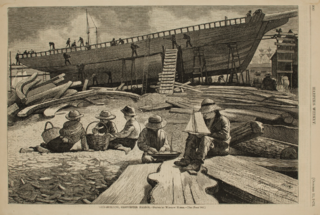
Shipbuilding is the construction of ships and other floating vessels. It normally takes place in a specialized facility known as a shipyard. Shipbuilders, also called shipwrights, follow a specialized occupation that traces its roots to before recorded history.

The Kon-Tiki expedition was a 1947 journey by raft across the Pacific Ocean from South America to the Polynesian islands, led by Norwegian explorer and writer Thor Heyerdahl. The raft was named Kon-Tiki after the Inca god Viracocha, for whom "Kon-Tiki" was said to be an old name. Heyerdal’s book on the expedition was entitled The Kon-Tiki Expedition: By Raft Across the South Seas. A 1950 documentary film won the Academy Award for Best Documentary Feature. A 2012 dramatized feature film was nominated for the Academy Award for Best Foreign Language Film.
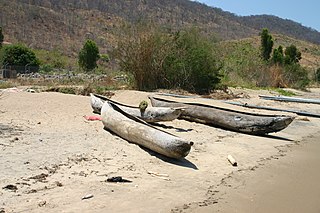
A dugout canoe or simply dugout is a boat made from a hollowed-out tree. Other names for this type of boat are logboat and monoxylon. Monoxylon (μονόξυλον) is Greek – mono- (single) + ξύλον xylon (tree) – and is mostly used in classic Greek texts. In German, they are called Einbaum. Some, but not all, pirogues are also constructed in this manner.

An inflatable boat is a lightweight boat constructed with its sides and bow made of flexible tubes containing pressurised gas. For smaller boats, the floor and hull are often flexible, while for boats longer than 3 metres (9.8 ft), the floor typically consists of three to five rigid plywood or aluminium sheets fixed between the tubes, but not joined rigidly together. Often the transom is rigid, providing a location and structure for mounting an outboard motor.
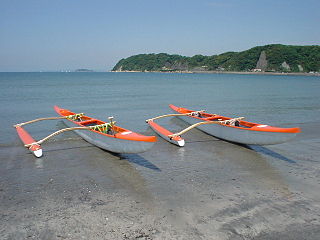
Outrigger boats are various watercraft featuring one or more lateral support floats known as outriggers, which are fastened to one or both sides of the main hull. They can range from small dugout canoes to large plank-built vessels. Outrigger boats can also vary in their configuration, from the ancestral double-hull configuration (catamarans), to single-outrigger vessels prevalent in the Pacific Islands and Madagascar, to the double-outrigger vessels (trimarans) prevalent in Island Southeast Asia. They are traditionally fitted with Austronesian sails, like the crab claw sails and tanja sails, but in modern times are often fitted with petrol engines.
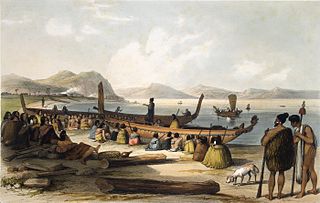
Waka are Māori watercraft, usually canoes ranging in size from small, unornamented canoes used for fishing and river travel to large, decorated war canoes up to 40 metres (130 ft) long.

The Uru or Uros are an indigenous people of Bolivia. They live on a still growing group of about 120 self-fashioned floating islands in Lake Titicaca near Puno. They form three main groups: the Uru-Chipaya, Uru-Murato, and Uru-Iruito. The Uru-Iruito still inhabit the Bolivian side of Lake Titicaca and the Desaguadero River.

Careening is a method of gaining access to the hull of a sailing vessel without the use of a dry dock. It is used for cleaning or repairing the hull. Before ship's hulls were protected from marine growth by fastening copper sheets over the surface of the hull, fouling by this growth would seriously affect the sailing qualities of a ship, causing a large amount of drag.

The crab claw sail is a fore-and-aft triangular sail with spars along upper and lower edges. The crab claw sail was developed in Island Southeast Asia some time before 2000 BCE. It went on to be used in many traditional Austronesian cultures in Island Southeast Asia, Micronesia, Island Melanesia, Polynesia, and Madagascar. Wind tunnel testing has shown it has impressive performance compared with the yardstick of Bermuda rig, with the vortices formed by the sail being suggested as a reason for the difference. It is sometimes known as the Oceanic lateen or the Oceanic sprit, even though it is not restricted to Oceania, is neither a lateen sail nor a spritsail, and has an independent older origin.

Drua, also known as na drua, n'drua, ndrua or waqa tabu, is a double-hull sailing boat that originated in the south-western Pacific islands. Druas do not tack but rather shunt. Both ends of each hull are identical, but the hulls are of different sizes and the smaller one is always sailed to windward. The main differences, compared to proas, are that the hulls have a symmetric U-form profile, and a second hull is used instead of an outrigger. When a float (cama) is used in place of the smaller hull, the craft is called a camakau.
The Fijian double canoe was the largest and finest sea-going vessel ever designed and built by natives of Oceania before contact with Europeans.

Polynesian navigation or Polynesian wayfinding was used for thousands of years to enable long voyages across thousands of kilometers of the open Pacific Ocean. Polynesians made contact with nearly every island within the vast Polynesian Triangle, using outrigger canoes or double-hulled canoes. The double-hulled canoes were two large hulls, equal in length, and lashed side by side. The space between the paralleled canoes allowed for storage of food, hunting materials, and nets when embarking on long voyages. Polynesian navigators used wayfinding techniques such as the navigation by the stars, and observations of birds, ocean swells, and wind patterns, and relied on a large body of knowledge from oral tradition.

The Kon-Tiki Museum is a museum in the Bygdøy peninsula in Oslo, Norway. It houses vessels and maps from the Kon-Tiki expedition, as well as a library with about 8,000 books. It was opened in a provisional building in 1949. In 1957, the current building—designed by architects F. S. Platou and Otto Torgersen—was opened. In 1978, an extension of the museum designed by Torgersen was opened.

Traditionally, many different kinds of boats have been used as fishing boats to catch fish in the sea, or on a lake or river. Even today, many traditional fishing boats are still in use. According to the United Nations Food and Agriculture Organization (FAO), at the end of 2004, the world fishing fleet consisted of about 4 million vessels, of which 2.7 million were undecked (open) boats. While nearly all decked vessels were mechanised, only one-third of the undecked fishing boats were powered, usually with outboard engines. The remaining 1.8 million boats were traditional craft of various types, operated by sail and oars.

Reed boats and rafts, along with dugout canoes and other rafts, are among the oldest known types of boats. Often used as traditional fishing boats, they are still used in a few places around the world, though they have generally been replaced with planked boats. Reed boats can be distinguished from reed rafts, since reed boats are usually waterproofed with some form of tar. As well as boats and rafts, small floating islands have also been constructed from reeds.
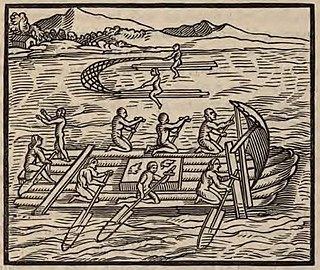
Pre-Columbian rafts plied the Pacific Coast of South America for trade from about 100 BCE, and possibly much earlier. The 16th-century descriptions by the Spanish of the rafts used by Native Americans along the seacoasts of Peru and Ecuador has incited speculation about the seamanship of the Indians, the seaworthiness of their rafts, and the possibility that they undertook long ocean-going voyages. None of the prehistoric rafts have survived and the exact characteristics of their construction and the geographical extent of their voyages are uncertain.

Abora is the name of several reed boats built by the German explorer Dominique Görlitz. The expeditions were inspired by previous trans-oceanic expeditions by the Norwegian explorer Thor Heyerdahl. Main aim of the Abora expeditions was to prove that a keel-less reed boat could be steered crosswise and against prevailing winds, using sideboards (leeboards) in lieu of a fixed keel. The name of the vessels was derived from the Canarian deity Abora.

The Austronesian vessels, are those devised or used by the Austronesian peoples of Taiwan, Maritime Southeast Asia, Micronesia, coastal New Guinea, Island Melanesia, Polynesia, and Madagascar that speak Austronesian languages. They also include indigenous ethnic minorities in Vietnam, Cambodia, Myanmar, Thailand, Hainan, the Comoros, and the Torres Strait Islands. The vessels have carried trade and migration across long distances in the region. They include monohulls, catamarans, outriggers, and proas. Sail types include a variety of crab-claw and tanja configurations.



















